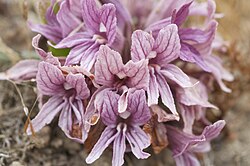| Orobanche californica | |
|---|---|
 | |
| Orobanche californica ssp. californica | |
| Scientific classification | |
| Kingdom: | Plantae |
| Clade: | Tracheophytes |
| Clade: | Angiosperms |
| Clade: | Eudicots |
| Clade: | Asterids |
| Order: | Lamiales |
| Family: | Orobanchaceae |
| Genus: | Orobanche |
| Species: | O. californica |
| Binomial name | |
| Orobanche californica | |
| Synonyms | |
List
| |
Orobanche californica, known by the common name California broomrape, is a species of broomrape. [2] It is a parasitic plant growing attached to the roots of other plants, usually members of the Asteraceae.
